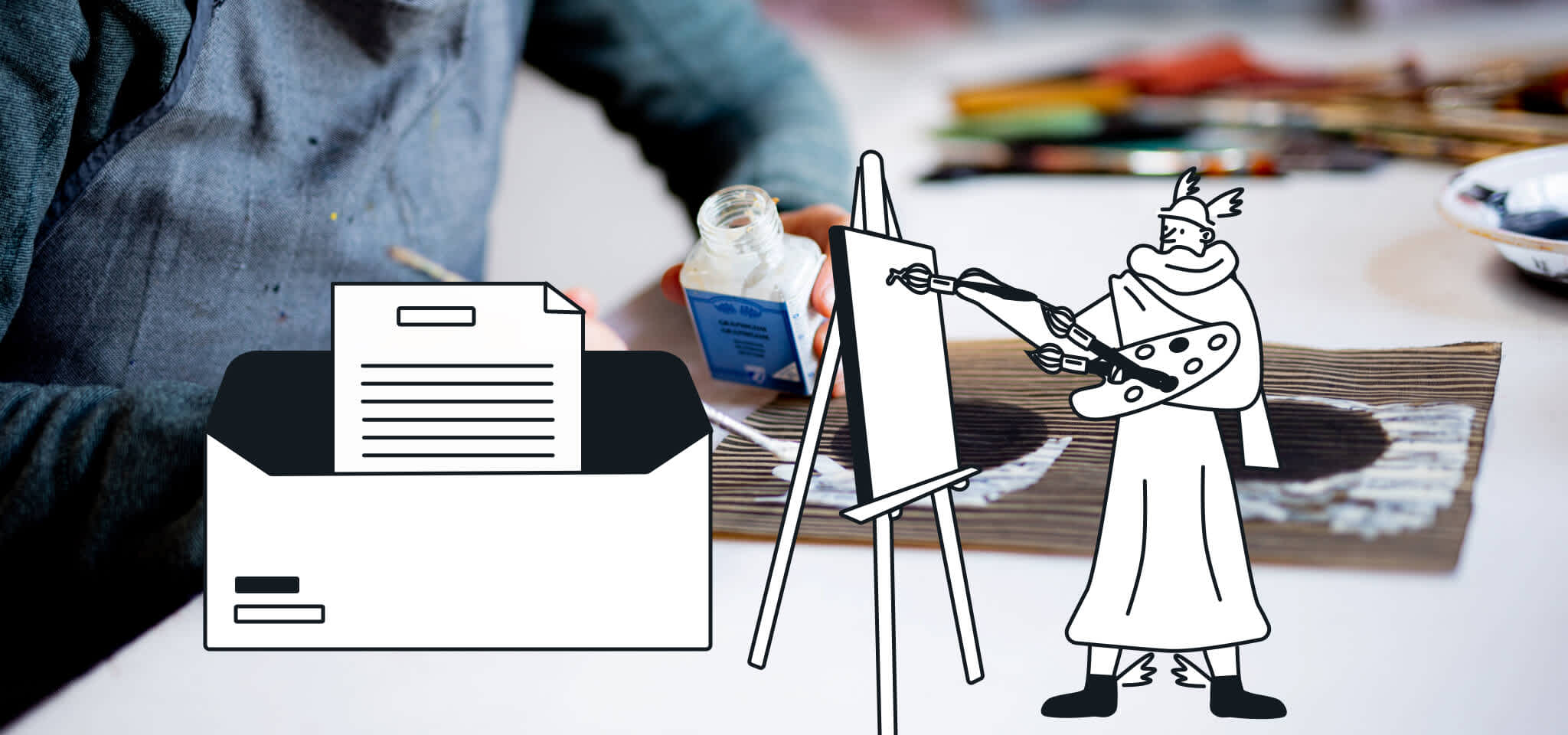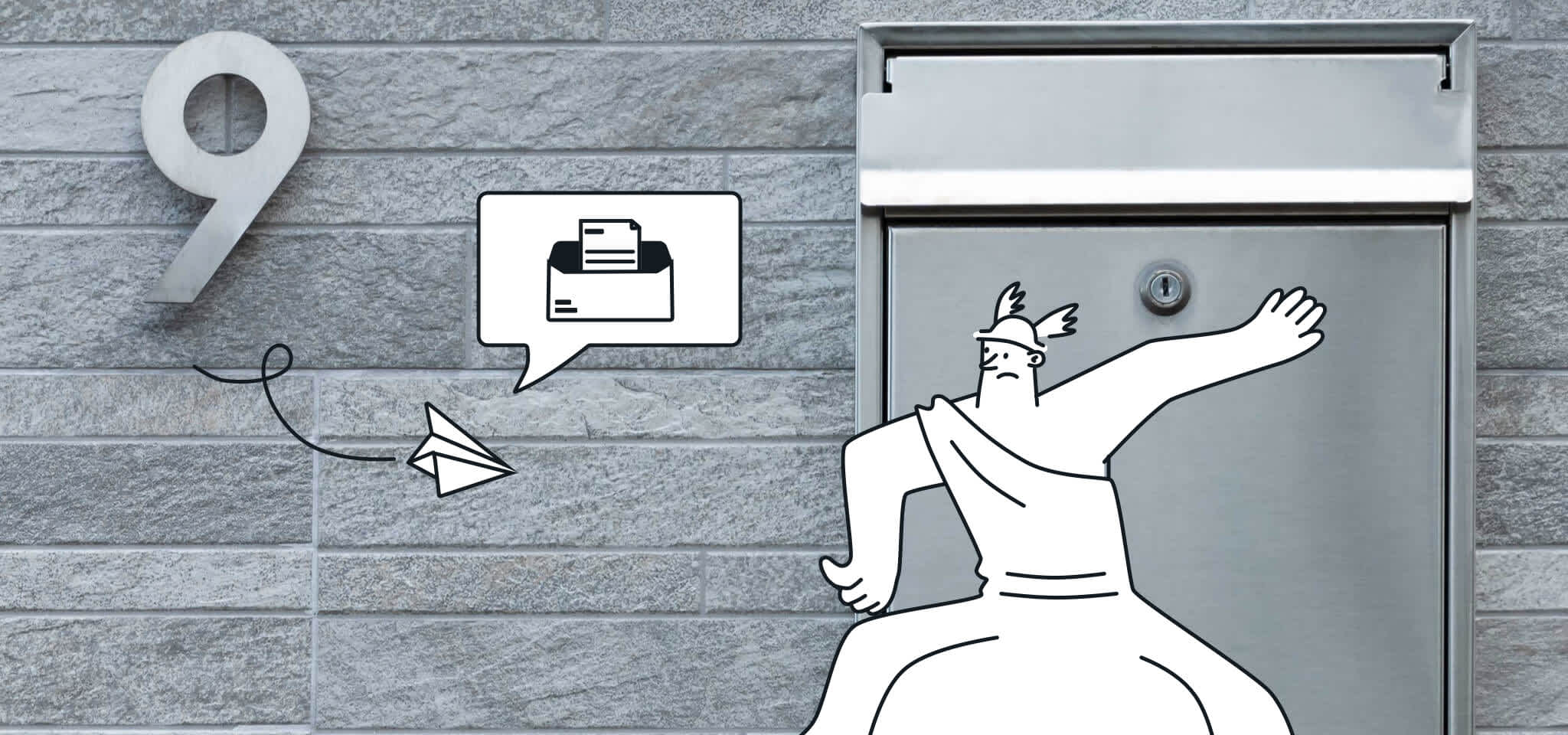Charities and not-for-profit organizations know what the secret to successfully tackling a mission is: building an army of fearless supporters to aid the cause they are fighting for. In order to build such a valiant army, you need emotive messaging and powerful storytelling that attracts the right breed of supporter: one who can convey your message.
So, how do you build this army of supporters with email? In this guide, we will cover the fundamentals of email marketing for the not-for-profit and charities.
Chapter 01
Defining a strong email strategy for charities & not-for-profits
Email marketing is a direct and truly personal way of grabbing your audience’s attention. It has the power to reach the right people, garnishing quick results and an impressive ROI. As we’ve already mentioned, email is the best performing channel for ROI, ahead of SEO.
Build an email contact list
Before you begin sending emails, you need to build a list that has the potential to convert. That is, a list of contacts that are interested in your mission. At Mailjet, we believe that success lies in growing your list organically and not from buying data.
The prospect of starting your contact list from scratch might seem daunting, but it is key to getting great results. Spending your budget by sending emails to people that are not interested in your cause is, at the end of the day, just wasting money.
Have a look at some quick tips to grow your contact list organically:
Your website: One of the simplest ways to collect contact email addresses is to add a newsletter sign-up widget, pop-up or light box to your website, encouraging supporters to create an account when making a donation or signing up to your services.
Social Media: Your social channels are fantastic places in which to run competitions, acquire donations, drive traffic to your website and subscribers to your newsletters. With that in mind, make sure you provide a sneak peek of the content your users could be receiving if they joined your mailing list.
Offline: Depending on the nature of your business, you might have face-to-face contact with your customers in physical stores, city centers, booths at events, etc… You can offer to send potential subscribers exclusive content, or incentivize them to join your contact list with unique gifts.
Growing (and maintaining) a healthy and engaged contact list is key to crafting a winning email marketing strategy.

Learn more:
Check out our “How to Build Your Email List Fast – Step-by-Step Guide” to master contact list building.
Read “14 Ideas To Increase Your Email List” to get new ideas to grow your database.
Master responsive email design
Today we might use two, three or maybe even four devices (desktops, tablets, smartphones, wearable…), all of which have different sized screens and display messages in different ways.
It is essential to keep these different screen sizes in mind when designing email templates. Responsive designs are those that render properly and deliver a consistent message, regardless of your contacts’ device or email client.
Learn more:
Head to our “Guide to Creating Responsive Emails” to learn more about design best practices.
Choose a responsive email editor
Ensuring your design is responsive might seem like a pain, but using an advanced email editor like Passport does the hard work for you. Adding interactive elements into your email can help to increase engagement, but these come with a more intense responsive battle. If you have a small amount of coding knowledge, tools like MJML can help to ease the pain.

Send data driven emails
Nowadays, there’s a lot of data email marketers can use to send better emails. However, we don’t always make the most of it. Analyzing and learning from all the information you have available to you will help you create campaigns that really answers your followers’ needs.
A/B testing allows email marketers to compare the performance of different versions of the same emails. The opportunities are endless – from the basics (from name, subject line, CTA) to aspects such as personalization, content, design, sending frequency or even sending days and times.
Another good way to assess the performance of your emails is comparing campaigns against each other. This will also allow you to look at the bigger picture, identify trends and set benchmarks for future sendings.
Create targeted and personalized content
Personalization and segmentation go hand in hand when it comes to email marketing.
Segmenting contact data, behavioral data, and data based on your users’ preferences will allow you to target them better and send them contextually relevant emails. Splitting your lists up by gender, location, behavioral patterns or donation value can help add context, making your subscribers feel like you know them.
On the other hand, personalizing your emails allows you to engage with your customers on a one-to-one basis, at scale. Personalization is not just about the simple things, like including your contact’s name in the subject line, but about using dynamic and tailored content that creates an emotional connection with each and every one of your readers.

Integrate marketing and transactional email
Traditionally, business emails have been divided into two big groups: marketing and transactional. Nowadays, though, organizations are expected to offer a seamless customer experience across both. By making sure your marketing and transactional emails have a consistent brand image, your customers will know they are communicating with the same organization.
Using marketing and transactional messages as two complementary email channels is not just about brand identity, though. It’s also about leveraging the power of these triggered messages and capturing your recipients when they are at their most engaged. Transactional emails, in general, have high engagement metrics, as they are sent to customers after they’ve performed an action.
Learn more:
Read our post “7 Marketing Ideas With Transactional Emails” to check out marketing opportunities to test in your transactional messages.
Learn about deliverability
Designing and sending amazing email campaigns that perfectly convey your organization’s mission is pointless if they’re not landing in the inbox. Even though the hard work seems over when you finally send your campaign, your emails go through a whole journey to reach your recipient. Many factors could determine whether your campaign lands in the inbox or the junk folder.
Learn more:
Head to our “Email Marketing Deliverability 101 Guide” to know more about email deliverability.
Chapter 02
Email campaigns for charities and not-for-profits
We’re sure that after spending quite some time learning about the tools and features that can help boost your email sendings, you’re eager to put it all into practice, armed with new ideas. Now it’s time to take a look at some of the marketing emails you can implement.
The not-for-profit and charity sectors can be extremely personal, with causes being very close to the recipient. Keeping your audience informed and treating your customers as individuals will strengthen your relationship with them and build brand loyalty.
Welcome programs
A welcome series gives you the opportunity to greet your customers upon joining your cause, and to offer them some key information to help them support you best. Letting your contacts know about the kind of communication they can expect from you and allowing them to choose between different options will enable you to send them targeted emails that are more likely to interest them.
You might want to consider breaking the welcome message down into a series of emails, to avoid bombarding your readers with lots of information in one go.

Four Freedoms Park Conservancy’s welcome email provides the reader with valuable information on what to expect and how to connect with the park. Their email is effective because it gives the reader clear paths to follow.
Newsletters
Sending out a frequent newsletter to all your subscribers is a great way to keep your contacts engaged. Regular content helps to promote your cause and keep members up to date with what you’re up to. Give your newsletter a catchy name to help readers recognize it in the inbox.

The Chang Zuckerberg Initiative newsletter shares current content about their work and other important updates.
Seasonal events
There are different ways in which seasonal events can be used to increase engagement with your email campaigns. Public holidays are always a great excuse to promote your cause and events. It could be that someone’s not thinking about giving or supporting a cause until they receive your email.
There are also certain festivities that make places or causes more attractive, like Halloween or Christmas… Piggybacking on whatever’s taking place in a specific location could be a good way to encourage someone to donate. Even designing creative campaigns around certain marketing moments can have a very positive impact on your conversion.
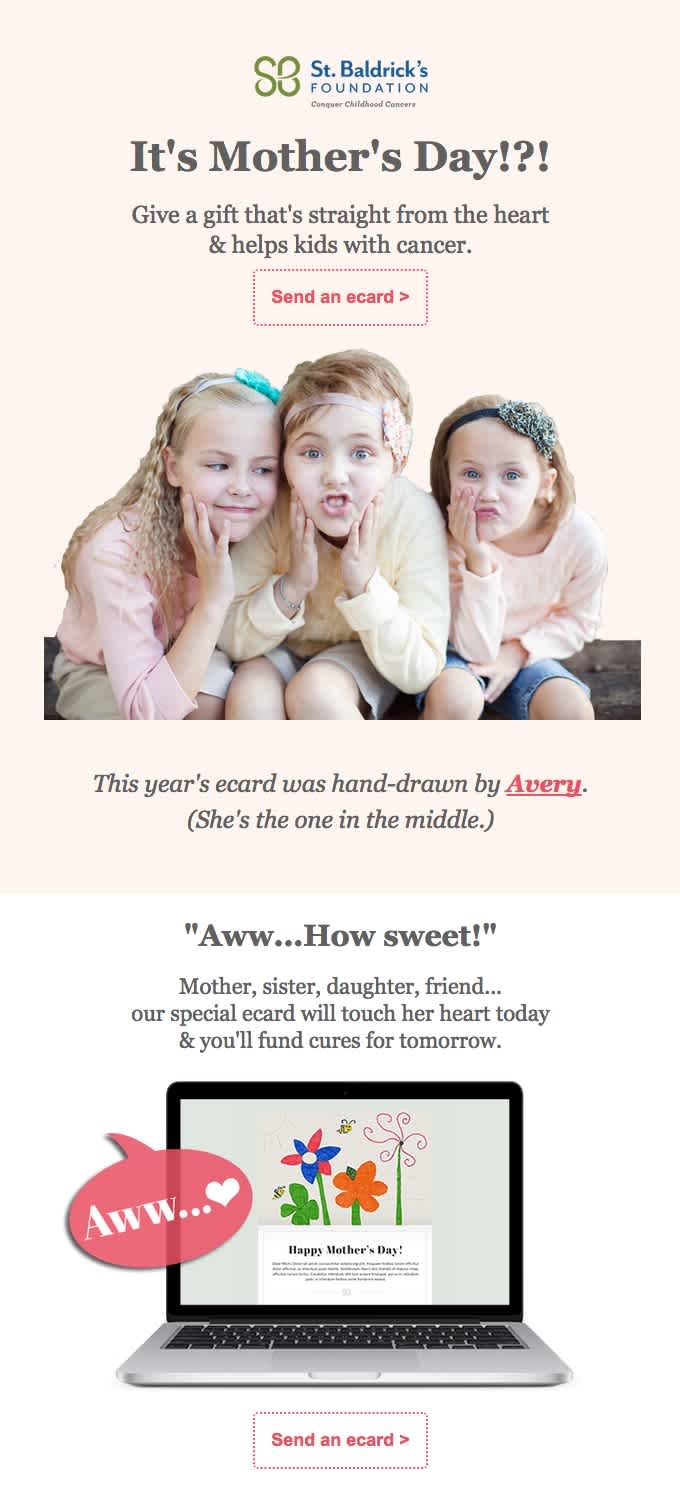
St Baldricks Foundation uses Mother’s Day to get donations by offering unique e-cards subscribers can send to their mothers.
Appeal launches and campaigning
Let your customers know what’s new and encourage them to get behind it, be it by donating, sharing on social media, or giving their feedback.

Red Clay’s Hurricane Dorian appeal email explains why they are supporting the cause with a clear call-to-action. They also include social links to help you spread the word.
Donation and volunteering requests
You’ve launched your appeal, but it doesn’t stop there: you need to ensure a steady stream of support. The best way to get support might be to be transparent, ask for what you want.
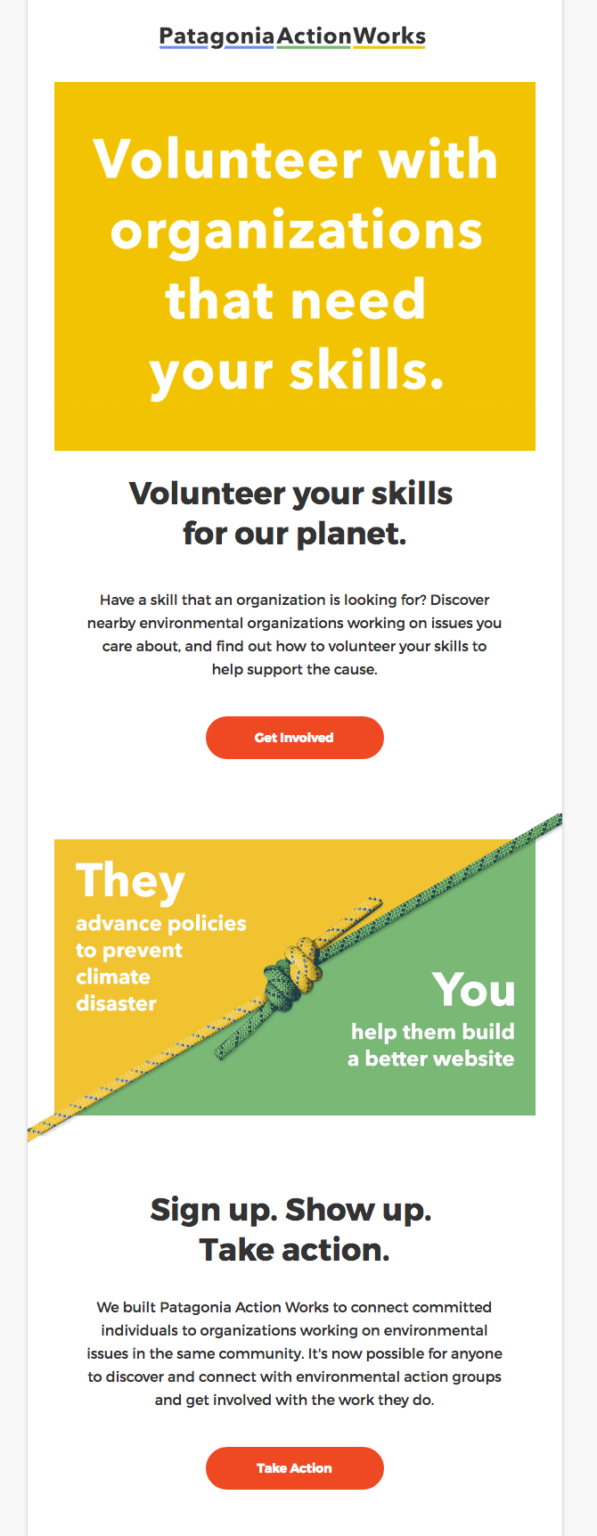
Patagonia is very straightforward with what they are asking the reader in this email example and how they can help.
Gifts and merchandise sales
Another way to get supporters to join your cause might be to offer gifts and merchandise for subscribers to buy their loved ones. Jumping on seasonal events might increase your conversion rate.

Pura Vida’s email highlights its partnership with the American Thyroid Association to encourage readers to support the cause by purchasing a bracelet.
Nurturing emails
How many times do you sign up to an email program, but never take action? Remind subscribers about your work and why it is important. You can even add a testimonial to help them to convert.

The Canadian Red Cross understands the importance of nurturing email recipients until they are ready to convert and donate, highlighting the work they are doing around the world.
Thank You messages
Once a subscriber has supported your cause by donating, volunteering or in another way, make sure you thank them for their help. This is a great opportunity to ask for their feedback and encourage them to share their story online, by directing them to your social media channels.
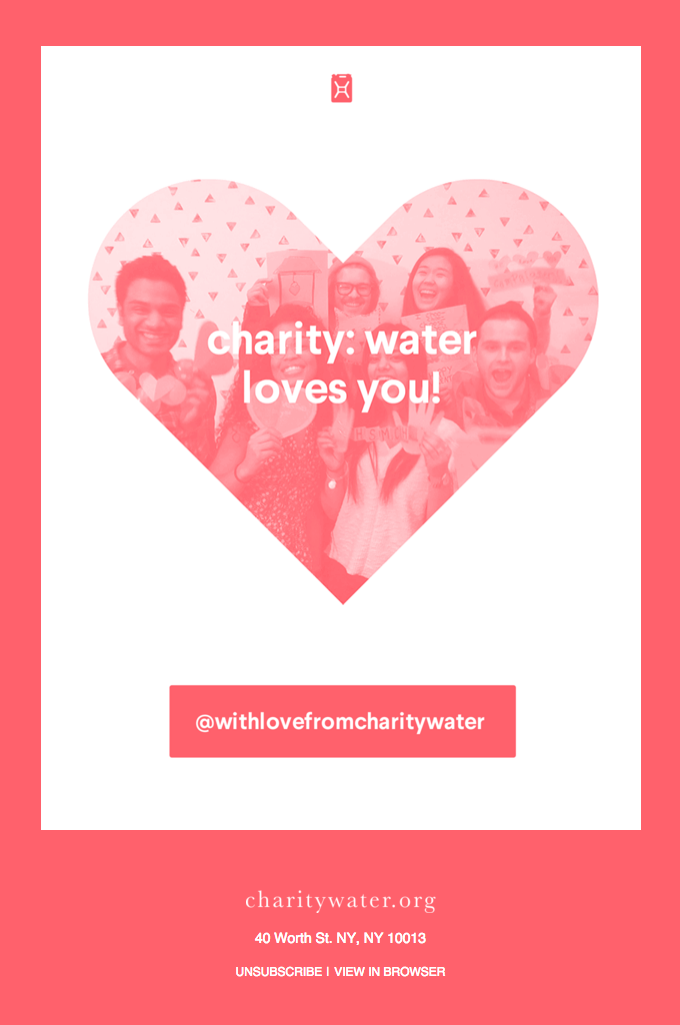
Charity Water understand the importance of thanking their supporters for their help. This Valentine’s Day email is a great way to show appreciation.
Update campaigns
Thanking supporters for aiding your cause is the first step, updating them on the progress of the cause is the second step. Letting the followers of your cause know where the mission is at can help to increase engagement, and perhaps encourage repeat donations.

Care Australia’s email is a great way of updating supporters on the progress they have made thanks to the support they receive.
Re-engagement emails
For most charities or not-for-profits, the support they receive might be a one-off. Other companies, though, rely on building a lasting relationship with their readers. If a supporter has recently stopped their donations, entice them back with a reactivation campaign. You can remind them about your mission, tempting them to support with powerful storytelling.

Cancer Research UK reminds people that stopped their donations during the previous year about the importance of their mission and ways to get involved.
Survey and feedback requests
As a not-for-profit or charity, you’ll understand the importance of taking your supporters on the journey with you to get their buy-in. Asking for their opinions can help increase engagement, and a survey email can help you do just that.

Feeding America asks their readers opinions, but also test their knowledge on the cause to see if their perceptions are in fact the reality of the situation.
Summing up
When used wisely, email is a really powerful channel that will not only help you build an army of fearless warriors for your cause, but also increase your ROI. Finding the right balance between mass communication and more personal messages is key to make the most out of your email strategy.
We’ve covered the fundamentals of email marketing, as well as the secret weapons you have at your disposal, some more advanced tools to help you convince recipients that your cause is a fight worth fighting, and some of the scenarios and email types you can add to your email marketing program to help you engage readers at the right time. Remember: the most important thing is to find what works for you and your subscribers, testing new ideas to maximize your email efforts.




